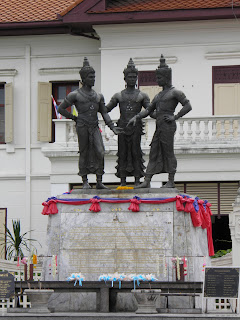Day 29-30: Chiang Mai, Thailand
Day One: Chiang Mai Old Town
Last night I committed another major travel area (I hope that you are jotting these down and learning from them), by going out drinking the night before and forgetting to buy a bottle of water on the way home. Given the choice of dying of thirst, or dying from water poisoning, I chose a wise middle ground of a mouthful of warm tap water. Luckily I suffered no adverse effects, but it was a close shave. I slept in and had a late breakfast, before heading down to the very impressive ‘Empress Hotel’ where Grant and Maria were staying - the grand entrance hall to the hotel couldn’t have been more of a contrast to the fact that I mine through the owner’s living room. They were happy for me to arrange a rough tour through the city and I was happy to take it easy and do a bit of vague wandering.
 |
| Chedis at Wat Suan Dok |
 |
| Wat Prah Singh Temple |
 |
| Three Kings Monument, Chiang Mai |
 |
| Ruins at Wat Chedi Luang |
Day Two: Doi Suthep, farewells and a hellish journey
 |
| The road up to Doi Suthep |
 |
| The golden chedi |
The temple was busy, but was pleasant enough and vast enough for there to be places to sit and admire the view, so I thought I would make the most of my minibus fare and sat for a while reading my book and taking photos. One of the most interesting aspects of the view as that Chiang Mai airport is located in the valley below and it was possible to watch big planes taking off from above - an experience that I don’t think I have ever had before. My minibus driver stopped at a few places on the drive back down to let me take some more photos - perhaps he felt sorry for me paying the whole fare, and we arrived back in town around mid afternoon.
 |
| Panorama of Chiang Mai from Doi Suthep |





0 comments